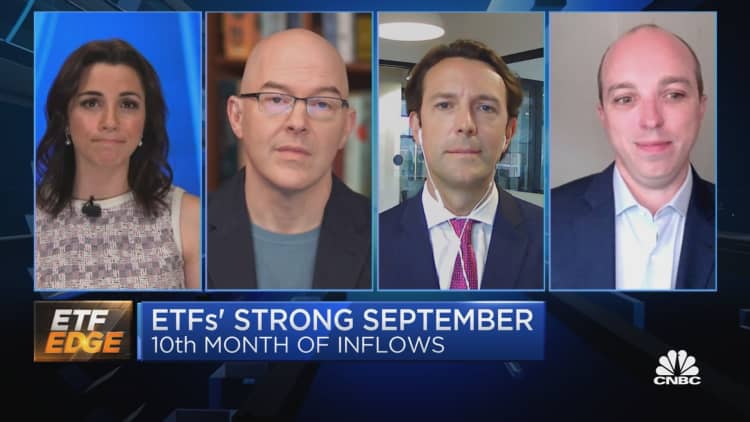
September may have been rough for stocks, but exchange-traded funds weren't steered off course.
U.S.-listed ETFs raked in some $46 billion in September, their 10th month in a row with more than $40 billion in inflows, according to State Street. So far this year, U.S. ETFs have pulled in a total of $640 billion, putting the industry on pace to break records by year-end.
The broader market's rut may have actually accelerated the move into ETFs last month, Dave Nadig, chief investment officer and director of research at ETF Trends, told CNBC's "ETF Edge" on Monday.
"The more volatility we have, the more people are going to look to ETFs."Dave NadigChief Investment Officer and Director of Research, ETF Trends
"History would suggest that the more volatility we have, the more people are going to look to ETFs," Nadig said. "Every time there's a drawdown, there's an opportunity for people to sell an underperforming active manager that maybe is in a mutual fund or to take a hit on a tax position."
That often leads investors to reevaluate their portfolio positions, he said.
"When they do that, they often end up back in the ETF market, often looking at fairly low-cost, fairly plain-vanilla-type equity exposures," Nadig said.
Lately, fixed income ETFs and inflation defense plays such as real estate have reaped the benefits, he said.
Sector ETFs also went from strength to strength in September, State Street's head of SPDR Americas research, Matthew Bartolini, said in the same interview.
"Sector ETFs have had inflows in 12 consecutive months. That's the longest streak they've ever had," he said. "Over that time frame, they've taken in $92 billion."
They were just one of September's highlights in the ETF space, Bartolini said: equity ETFs overall took in $18 billion, Treasury inflation-protected securities funds got $3 billion, sector ETFs — particularly energy funds — took in $2 billion and bank loan funds took in almost $1 billion.
In many ways, the action reflects a "lack of leadership in the marketplace," he said, with "a multitude of investor types expressing viewpoints within ETFs."
For example, on the sector side, inflows into energy ETFs coincided with an increase in call option volumes, Bartolini said.
"We're still seeing a lot of investors utilize the construct of sector ETFs to play specific tactical asset allocations, particularly when return dispersion is so high, and I'd expect that to continue because we are headed into the fourth quarter," historically the most volatile quarter of the year, he added.
"That macro risk calendar is pretty full when you think about what's going on down in Washington."





